# EMSC 3002 ## Structures Associated with Folding: Type of Axial Surface Foliation - Louis Moresi (convenor) - **Romain Beucher** (lecturer) - Chengxin Jiang (lecturer) - Stephen Cox (curriculum advisor) Australian National University _**NB:** the course materials provided by the authors are open source under a creative commons licence. We acknowledge the contribution of the community in providing other materials and we endeavour to provide the correct attribution and citation. Please contact louis.moresi@anu.edu.au for updates and corrections._ <--o--> ## Resources 1. **Fossen, H, 2011.** *Structural Geology.* Cambridge University Press, 2nd Edition **Chapter 12** 1. **McClay, K.R. 1991.** *The Mapping of Geological Structures.* John Wiley & Sons. **Chapter 4** 1. **Park, R.G., 1995.** *Foundations of Structural Geology.* Blackie & Sons Ltd. **Chapter 3** 1. **Davis, G.H. and Reynolds, S.J., 1996.** *Structural Geology of Rocks and Regions.* 2nd Edition, John Wiley & Sons. **Chapter 8** <!-- 1. **Hatcher, R.D., 1990.** *Structural Geology - Principles, Concepts, and Problems*, 2nd Edition, Prentice-Hall --> <!-- 1. **Ramsay, J.G. and Huber, M.I. 1983.** *Modern Structural Geology. Volume 1: Strain Analysis.* Academic Press. --> <!-- 1. **Ramsay, J.G. and Huber, M.I. 1987.** *Modern Structural Geology. Volume 2: Folds and Fractures.* Academic Press. --> <--o--> ## Intended learning outcomes In this module we cover basic and important aspects of foliations and cleavage. We learn how to distinguish between different types of foliations, understand how they form, and their relation to lithology and physical conditions. <--o--> ## Definition: Fabric <div> <div style="width:50%; float:left"> The term **fabric** is used to describe penetrative and distributive components of rock masses. A fabric is built of minerals and mineral aggregates with a *preferred orientation* that *penetrate the rock* at the *microscopic to centimeter scale* The distance between the elements is typically less than 10cm which excludes sets of faults and small shear zones as fabric elements. *Primary fabric in anorthosite intrusion, Rogaland, Norway* source: [Wikipedia](https://en.wikipedia.org/wiki/Fabric_(geology)#/media/File:Primary_fabric_Jibbeheia.JPG) </div> <div style="width:50%; float:right">  <!-- .element style="float: right" width="95%" --> </div> </div> <--o--> <!-- .slide: data-background="Module-v-Ductile-Deformation/Figures-Structures-Associated-with-Folding-1/Photos/Wikipedia_1280px-Primary_fabric_Jibbeheia.jpeg" --> <--o--> <div> <div style="width:60%; float:left"> **Primary fabrics** are acquired during the formation of the rock (sedimentary or magmatic fabrics). They need to be accounted for when considering the deformation history of a rock. Any fabric that does not result from the deformation of a rock. Metamorphic rocks typically show **strong fabrics** and are often referred as **Tectonites**. **L-Tectonites** show Linear fabrics while **S-Tectonites** have Planar fabrics. *Deformed waterlain volcanic sediments. Primary fabric (bedding) shown by abrupt change in clast size, secondary fabric shown by penetrative S-fabric, cleavage, in fine-grained rock, and by shape fabric in deformed volcanic clasts. Cape Forchu, Nova Scotia.* source: [Wikipedia](https://en.wikipedia.org/wiki/Fabric_(geology)#/media/File:Primary_and_secondary_fabrics.JPG) </div> <div style="width:40%; float:right">  <!-- .element style="float: right" width="90%" --> </div> </div> <--o--> <!-- .slide: data-background="Module-v-Ductile-Deformation/Figures-Structures-Associated-with-Folding-1/Photos/Wikipedia_800px-Primary_and_secondary_fabrics.jpeg" --> <--o--> ### Linear, Planar and Random fabrics <div> <div style="width:50%; float:left"> - **Linear Fabric**: Elongated elements with preferred orientation - **Planar Fabric**: Tabular or platy elements with common orientation. The fabric does not need to be planar in a mathematical sense. It can be affected by folding and wrap around stronger elements. - **Random Fabric**: No preferred orientation. Undeformed sedimentary rocks, igneous rocks. </div> <div style="width:50%; float:right">  <!-- .element style="float: right" width="90%" --> *Stretching Lineation in amphibolite (Cap de Creus) Jordi Carreras Planells* </div> </div> <--o--> <!-- .slide: data-background="Module-v-Ductile-Deformation/Figures-Structures-Associated-with-Folding-1/Photos/Hornblende_Lineations.jpeg" --> <!-- Hornblende lineation in orthogneiss. Big Silver Creek., Harrison Lake, BC. [49.696595,-121.816864]> --> <--o--> ### Linear, Planar and Random fabrics <div> <div style="width:50%; float:left"> - **Linear Fabric**: Elongated elements with preferred orientation - **Planar Fabric**: Tabular or platy elements with common orientation. The fabric does not need to be planar in a mathematical sense. It can be affected by folding and wrap around stronger elements. - **Random Fabric**: No preferred orientation. Undeformed sedimentary rocks, igneous rocks. </div> <div style="width:50%; float:right">  <!-- .element style="float: right" width="90%" --> </div> </div> *Jurassic slate in La Grave (Hautes-Alpes, France). These rocks easily split along foliation surfaces that dip towards the left of the image. Credit: Samuele Papeschi* source: [EGU Blog](https://blogs.egu.eu/divisions/ts/2019/08/30/features-from-the-field-foliation) <--o--> ## Definition: Foliation <div> <div style="width:50%; float:left"> **Foliation** (lat: *folium*, leaf) Any forming-fabric *planar* or *curviplanar* structure in a metamorphic rock. A foliation may be defined by zone of different grain size, flattened objects, recrystallized tabular grains with a uniform orientation, platy mineral arranged into millimeter thick domains, densely distributed and cohesive micro-fractures, micro-folds (crenulations). A foliated rock is by definition *cohesive* but may break preferentially along the foliation. </div> <div style="width:50%; float:right"> 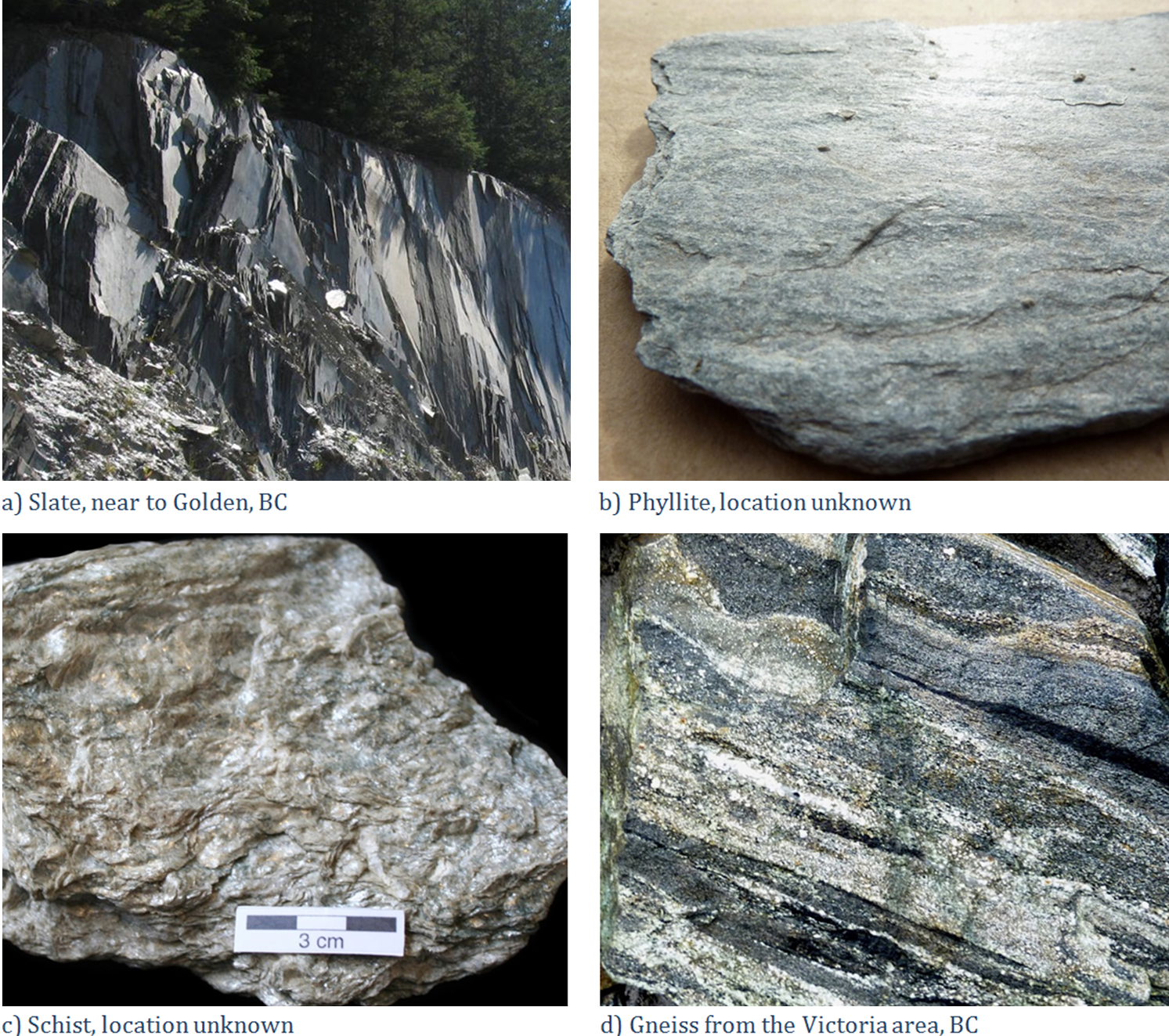 <!-- .element style="float: right" width="90%" --> </div> </div> <--o--> ## Definition: Foliation <div> <div style="width:50%; float:left"> Foliations are the most common class of features in deformed Metamorphic Rocks. - They influence topography and landscape - They make good building materials (e.g. slates) - They reflect the finite strain. </div> <div style="width:50%; float:right"> 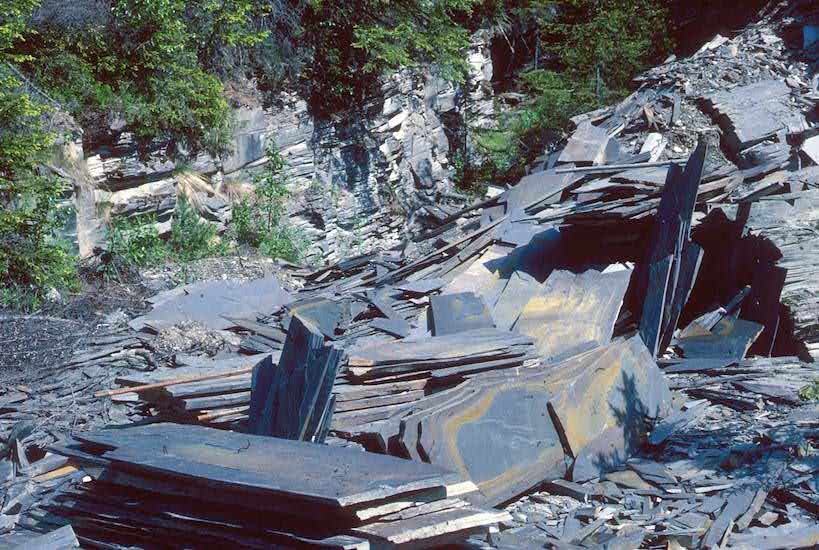 <!-- .element style="float: right" width="90%" --> </div> </div> <--o--> ## Definition: Foliation 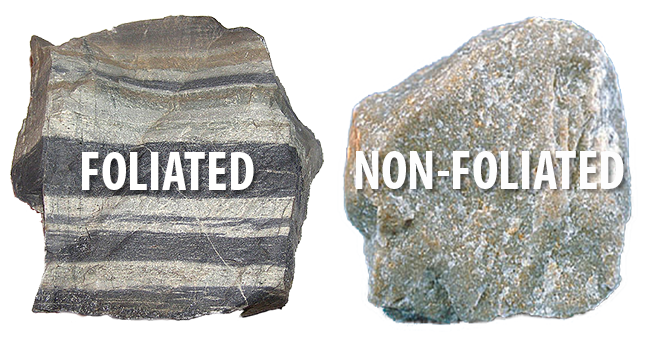 <!-- .element style="float: right" width="90%" --> <--o--> ### Primary foliation vs Secondary foliation Geologists usually prefer to reserve the term foliation for plane structures formed by *tectonic strain*. However, the term is also used for primary sedimentary bedding and magmatic layering. We often distinguish between **Primary foliation** which includes bedding, flow banding lavas and magmatic layering, and **Secondary foliation** for products of stress and strain. **Secondary foliation** is a **Tectonic foliation**. A planar structure formed by tectonic processes. It includes **cleavages**, **shistosity** and **mylonitic foliations**. <--o--> ### Primary foliation vs Secondary foliation <div> <div style="width:50%; float:left"> 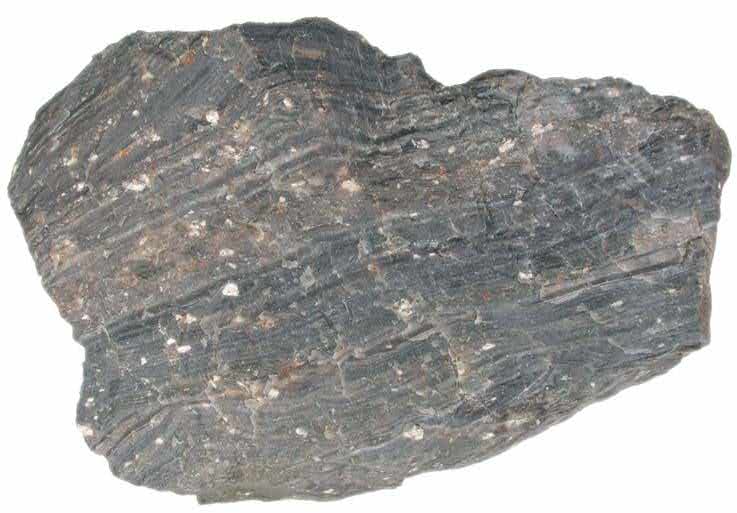 <!-- .element style="float: right" width="90%" --> *Primary foliation (flow banding) in rhyolite, Iceland* </div> <div style="width:50%; float:right">  <!-- .element style="float: right" width="90%" --> *Folded foliation affected by cleavage. Drawing by H. Reush* </div> </div> <--o--> ## Definition: Cleavage The term **cleavage** describe the ability of a rock to split, or cleave, into more or less parallel surfaces. **cleavage** is a subgroup of **foliations** (not all foliated rocks split preferentially along the foliation). **cleavage** is found in very-low grade metamorphism and in micaceous gneisses or shists in the form of late-stage crenulation. Do not confuse with crystallographic cleavage which is the tendency of minerals to break along crystallographic planes). <--o--> <!-- .slide: data-background="Module-v-Ductile-Deformation/Figures-Structures-Associated-with-Folding-1/Photos/cleavage.jpg" --> <--o--> ## Processes <div> <div style="width:50%; float:left"> ### Rigid Grain Rotation Rigid rotation of grains. Not as important as originally thought but can be important for rocks with very rigid minerals such as amphiboles and feldspars in a softer matrix. Most important for non-metamorphic conditions where temperature is too low to allow for crystallization to occur and where pressure solution is limited. See **Compaction Cleavage** </div> <div style="width:50%; float:right"> 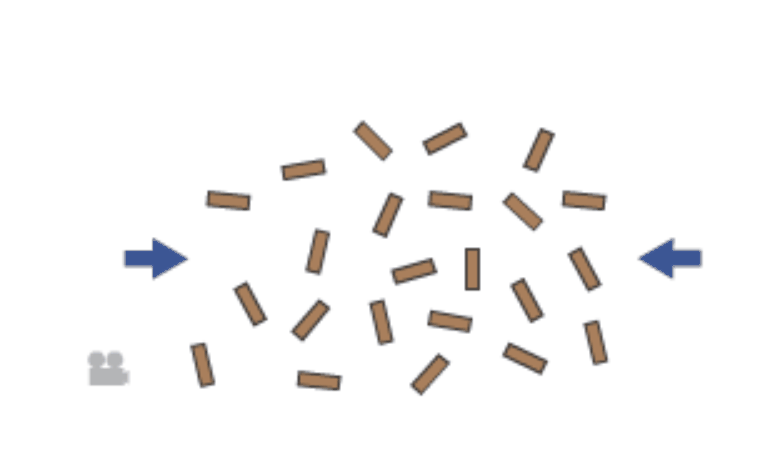 <!-- .element style="float: right" width="90%" --> </div> </div> <--o--> ## Processes <div> <div style="width:50%; float:left"> ### Grain Bending Some minerals such as phyllosilicates are flexible, even at surface temperature and can be bent under stress. Bending can be seen as a **Flexural slip** process (see lecture on folding) Bending is mostly important for platy minerals. </div> <div style="width:50%; float:right">  <!-- .element style="float: right" width="90%" --> </div> </div> <--o--> ## Processes <div> <div style="width:55%; float:left"> ### Pressure Solution Dissolution of minerals along grain boundaries at high angles to $\sigma_1$ and redeposition of the material can strain the grains so that they obtain a preferred orientation (i.e. A fabric that defines a foliation.) Important factors are: - Stress conditions at the grain contacts - Temperature - Presence of fluid around the grain and the contrast in composition Precipitation of the material can occurs cm away at boundaries oriented at high angle to $\sigma_3$ or the material can be transported out of the rock. </div> <div style="width:45%; float:right"> 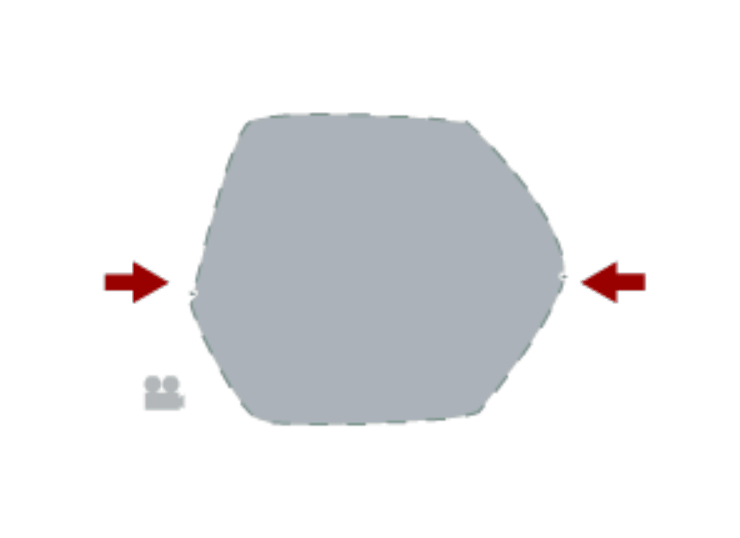 <!-- .element style="float: right" width="70%" -->  <!-- .element style="float: right" width="70%" --> </div> </div> <--o--> ## Processes <div> <div style="width:50%; float:left"> ### Recrystallization Recystallization of minerals require a certain temperature to operate. Quartz requires temperature of 300C. Recrystallization involves transformation of grains into grains with new shapes as dislocation migrate and defects diffuse within the crystal **New mineral** grow when original mineral become unstable due to change in pressure and/or temperature. They grow with a preferred orientation and contribute to the formation of the foliation. **Recrystallization** is very important at amphibolite and granulite facies condition. Pressure solution is more important during lower-grade conditions. </div> <div style="width:50%; float:right"> 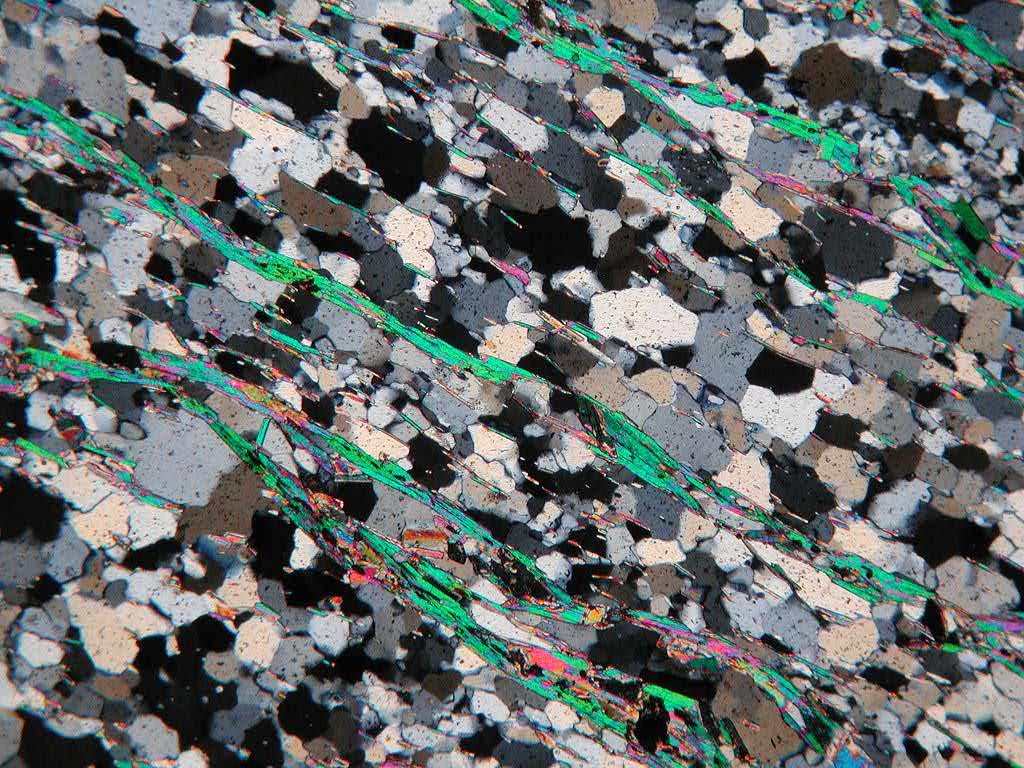 <!-- .element style="float: right" width="90%" --> </div> </div> <--o--> ## Cleavage development **cleavage** is the low-temperature type of **foliation** and is best developed in rocks with abundant platy minerals (philosilicates) Sedimentary rocks containing platy minerals tend to develop cleavage quite easily. Temperature increases with crustal depth and as it increases so is the mobility of minerals and the potential for recrystallisation. Cleavage usually develops at temperature below $350-370C$. At higher temperature we see **Shistosity** and **Mylonite foliations**. **Let's see how cleavage and foliation devellop as we increase the temperature and pressure conditions.** <--o--> <!-- .slide: data-background="Module-v-Ductile-Deformation/Figures-Structures-Associated-with-Folding-1/Photos/edinburg-anno.jpg" --> <--v--> **Edinburg Formation in western Virginia** Both primary bedding and secondary cleavage can be discerned in this outcrop of Edinburg Formation in western Virginia. The bedding is Ordovician is age, but the cleavage was superimposed later, during late Paleozoic mountain-building. [source: OpenGeology](https://opengeology.org/historicalgeology/case-studies/palimpsest-outcrops/) <--o--> ## Shorthand nomenclature <div> <div style="width:60%; float:left"> We use the designation **$S_n$** for foliations, with the **$n$** subscript indicating relative age ($S_0$, $S_1$, $S_2$ etc.) **$S_0$** referred to the primary foliation, e.g the bedding for a sedimentary rock. As folds and foliations are often related we associate **$S_1$**, **$S_2$**, **$S_3$**... to generations of folds **$F_1$**, **$F_2$**, **$F_3$**... We can also refer to deformation phases as **$D_1$**, **$D_2$**, **$D_3$**... </div> <div style="width:40%; float:right">  <!-- .element style="float: center" width="90%" --> </div> </div> <--o--> <!-- .slide: data-background="Module-v-Ductile-Deformation/Figures-Structures-Associated-with-Folding-1/Photos/Bedding_cleavage_relationships.jpg" --> <--o--> ### Lithology Lithology is important as different minerals react differently to temperature. Philosilicates are important and facilitate cleavage development. In calcareous rocks, which are generally poor in philosilicates, cleavage is controlled by the mobility of carbonate and the development of stylolites. <--o--> ### Development of Secondary foliations: compaction cleavage <div> <div style="width:70%; float:left"> 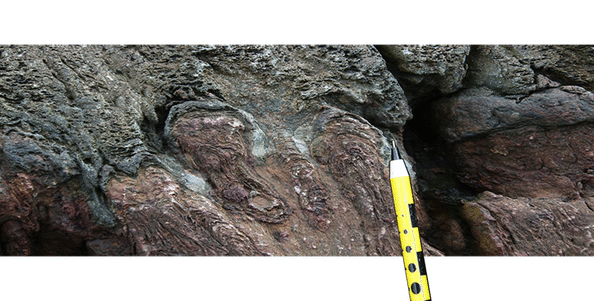 <!-- .element width="90%" --> [source: OpenGeology.org](https://opengeology.org/historicalgeology/case-studies/palimpsest-outcrops/) </div> <div style="width:30%; float:right">  <!-- .element style="float: right" width="90%" --> </div> </div> <--v--> **Keels, Newfoundland** Stromatolites are ancient microbial mats that domed upward toward the sunlight as they grew. They were laid down in sticky layers of slime by photosynthetic microbes, probably cyanobacteria. But that’s not all we see here. The tectonic cleavage is also a prominent feature of these rocks. Here, you can see bedding marked out by the different colored layers going left-to-right across the outcrop, while cleavage is more or less vertical, and etched out by seaside weathering: [source: OpenGeology](https://opengeology.org/historicalgeology/case-studies/palimpsest-outcrops/) <--o--> ### Development of Secondary foliations: compaction cleavage <div> <div style="width:50%; float:left"> Non-tectonic cleavage and thus often regarded as $S_0$. Compaction results in reorientation of mineral grains and collapse of pore space. It usually accentuate and rework the primary foliation $S_0$. A clay or claystone will then results in a shale with **compaction cleavage** </div> <div style="width:50%; float:right">  <!-- .element style="float: right" width="90%" --> </div> </div> <--o--> ### Development of Secondary foliations: compaction cleavage <div> <div style="width:50%; float:left"> Non-tectonic cleavage and thus often regarded as $S_0$. Compaction results in reorientation of mineral grains and collapse of pore space. It usually accentuate and rework the primary foliation $S_0$. A clay or claystone will then results in a shale with **compaction cleavage** </div> <div style="width:50%; float:right"> 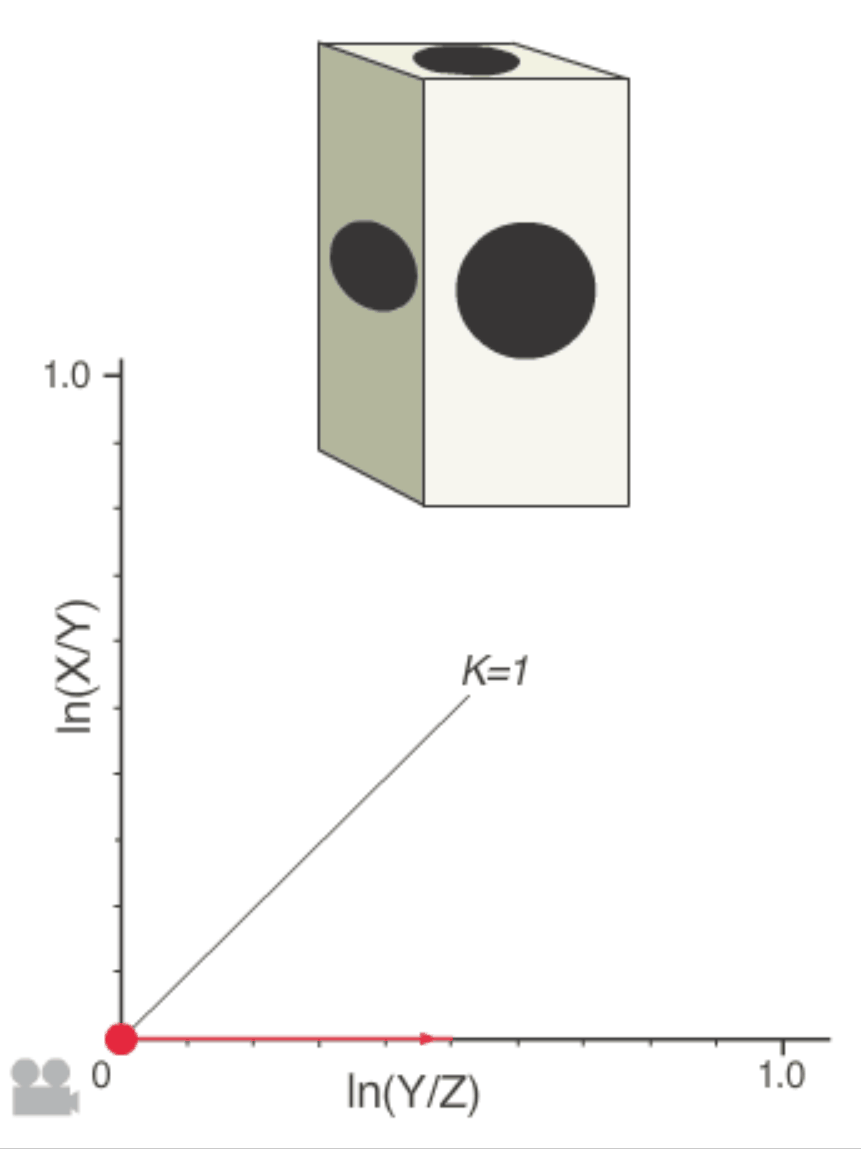 <!-- .element style="float: right" width="80%" --> </div> </div> <--o--> #### Pressure solution <div> <div style="width:50%; float:left"> Pressure solution or Wet diffusion can occur. Very common in carbonates where quartz or carbonates are dissolved and result in concentration of residual minerals. This also happens in clay and claystone where the dissolution of quartz results in concentration of clay minerals. The seams are **stylolites** and the foliation can be called a **stylolite cleavage** or a **pressure solution cleavage**. </div> <div style="width:50%; float:right"> 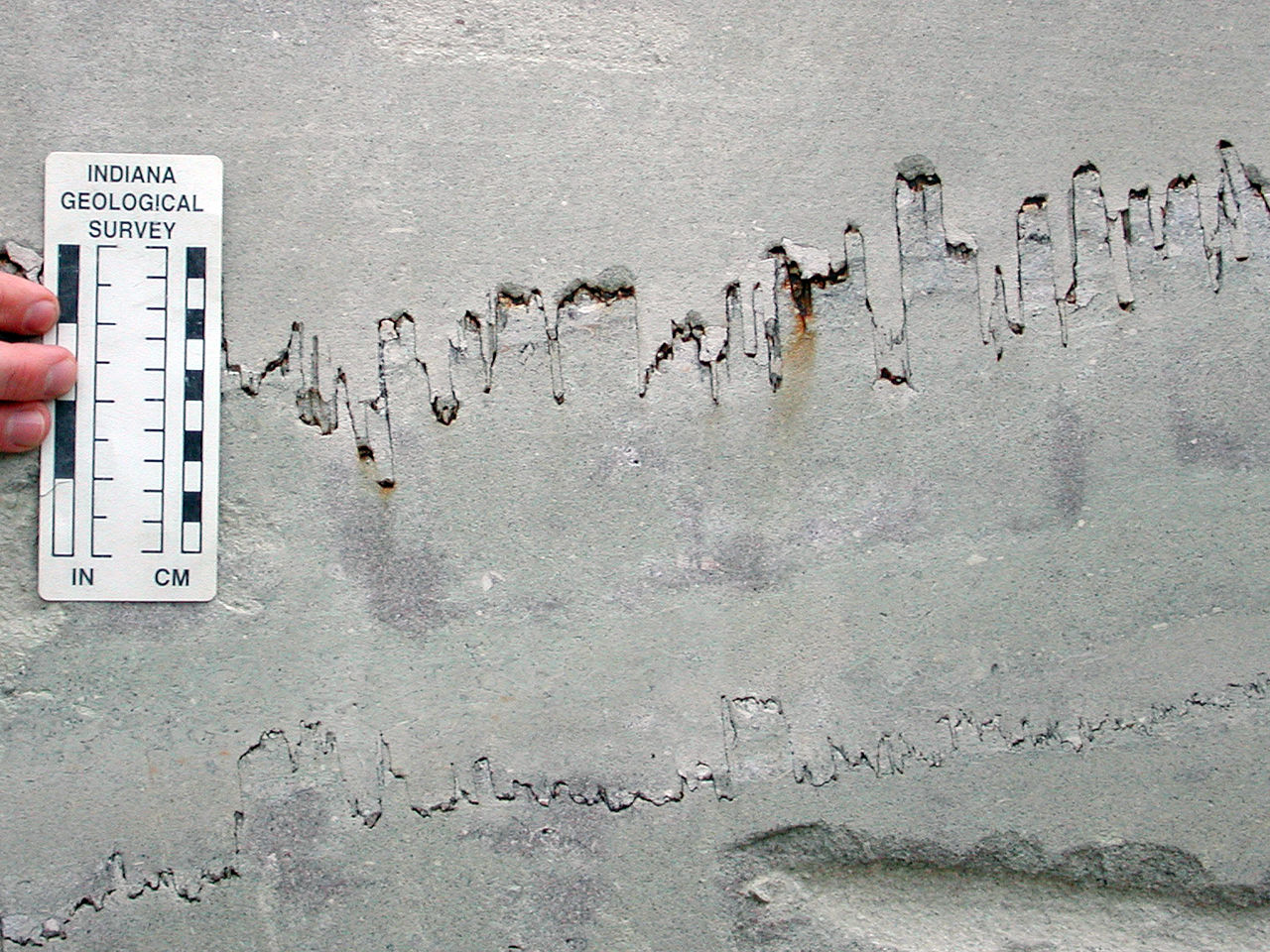 <!-- .element style="float: right" width="90%" --> </div> </div> <--o--> <!-- .slide: data-background="Module-v-Ductile-Deformation/Figures-Structures-Associated-with-Folding-1/Photos/Stylolite_oehrlikalk_1b_wikipedia.jpg" --> <--o--> #### Pressure solution <div> <div style="width:70%; float:left"> Minerals diffuse away, perpendicular to the direction of $\sigma 1$, through a very thin film of fluid along the grain boundaries and precipitate in pressure shadows of larger and/or more rigid grains or are simply transported out of the rocks. Very significant amount of material is lost through **pressure solution**. This presents interesting consequences in terms of thermodynamics and fluid flow though the crust. </div> <div style="width:30%; float:right">  <!-- .element style="float: right" width="90%" --> </div> </div> <--o--> <!-- .slide: data-background="Module-v-Ductile-Deformation/Figures-Structures-Associated-with-Folding-1/Figures/Fossen_Chap10_GR08.jpg" --> <--o--> ### Development of Secondary foliations #### Early tectonic development <div> <div style="width:50%; float:left"> Rock (e.g. sedimentary rock) exposed to tectonic stress that leads to progressive shortening of sedimentary beds. Typical of foreland regions of orogenic belts. In limestones and sandstones, the first foliation to form is a pressure solution cleavage, typically stylolithic. </div> <div style="width:50%; float:right">  <!-- .element style="float: right" width="90%" --> </div> </div> <--o--> <!-- .slide: data-background="Module-v-Ductile-Deformation/Figures-Structures-Associated-with-Folding-1/Photos/stylolites.jpeg" --> <--v--> Stylolites (pressure solution seams) in limestone of Mississippian age, exposed on the side of a rounded boulder in Hyalite Canyon, Gallatin Range, Montana. These stylolites, like most, are bedding-parallel, and thus most likely formed due to the weight of the overlying rock. Calcite, the dominant mineral, goes into solution under pressure, and insoluble material, like organic matter and clay, accumulates along the dissolution surface, producing a dark, wiggly line. Here, multiple stylolites have converged and overprinted one another, resulting in a mutli-level “oscilloscope” look. [source: Callan Bentley](https://blogs.agu.org/mountainbeltway/2011/07/12/stylolites-in-mississippian-limestone) <--o--> ### Development of Secondary foliations #### Early tectonic development <div> <div style="width:50%; float:left"> If $\sigma 1$ is horizontal, this result in a $S_1$ cleavage that is at high angle with $S_0$. When $S_0$ and $S_1$ are equally marked, we can obtain a **pencil cleavage**: the rock will fracture along both $S_0$ and $S_1$ along pencil shaped fragments. **Pencil cleavage** can also occur because of change in the regional stress field. </div> <div style="width:50%; float:right">  <!-- .element style="float: right" width="90%" --> </div> </div> <--o--> ### Development of Secondary foliations #### Early tectonic development <div> <div style="width:50%; float:left"> If $\sigma 1$ is horizontal, this result in a $S_1$ cleavage that is at high angle with $S_0$. When $S_0$ and $S_1$ are equally marked, we can obtain a **pencil cleavage**: the rock will fracture along both $S_0$ and $S_1$ along pencil shaped fragments. **Pencil cleavage** can also occur because of change in the regional stress field. </div> <div style="width:50%; float:right"> 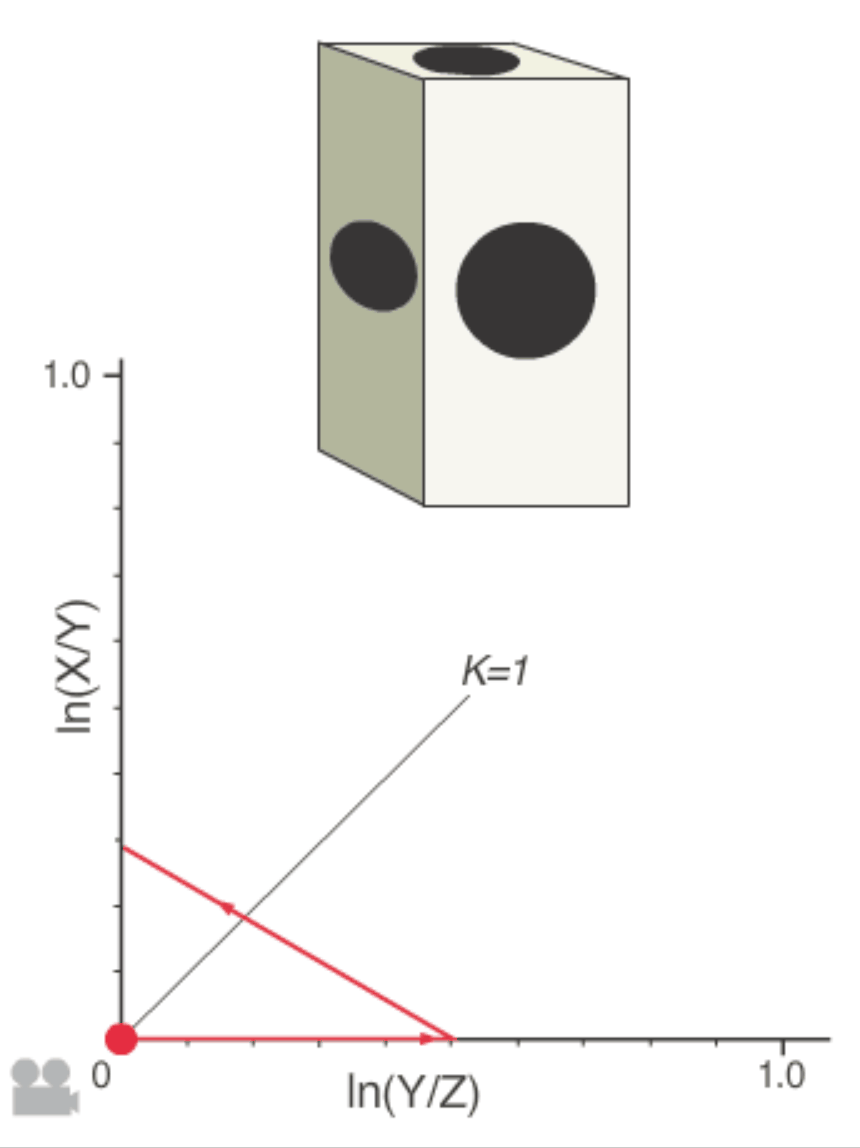 <!-- .element style="float: right" width="80%" --> </div> </div> <--o--> <!-- .slide: data-background="Module-v-Ductile-Deformation/Figures-Structures-Associated-with-Folding-1/Photos/Pencil_Cleavage_Sandra_Mclaren.jpeg" --> <--o--> <!-- .slide: data-background="Module-v-Ductile-Deformation/Figures-Structures-Associated-with-Folding-1/Photos/1280px-Pencil_Cleavage_wikipedia.jpeg" --> <--o--> <!-- .slide: data-background="Module-v-Ductile-Deformation/Figures-Structures-Associated-with-Folding-1/Photos/Fossen_Chap12_PencilCleavage.jpg" --> <--o--> ### Development of Secondary foliations #### Early tectonic development <div> <div style="width:50%; float:left"> If the tectonic shortening persist, $S_1$ eventually dominates the structure and texture of the rock. We obtain a **slate**, a **slaty cleavage**. The metamorphism is low. We are at the very beginning of recristallisation of clay minerals. Cleavage forms through grain rotation, growth of minerals with a preferred direction, and most importantly **pressure solution** of the most solvent minerals in the rock at the microscopic scale. We can thus observe **domainal cleavage** with **Quartz-Feldspar (QF) Domain** and **philosilicates (M) Domain**. </div> <div style="width:50%; float:right">  <!-- .element style="float: right" width="90%" --> </div> </div> <--o--> ### Development of Secondary foliations #### Early tectonic development <div> <div style="width:50%; float:left"> If the tectonic shortening persist, $S_1$ eventually dominates the structure and texture of the rock. We obtain a **slate**, a **slaty cleavage**. The metamorphism is low. We are at the very beginning of recristallisation of clay minerals. Cleavage forms through grain rotation, growth of minerals with a preferred direction, and most importantly **pressure solution** of the most solvent minerals in the rock at the microscopic scale. We can thus observe **domainal cleavage** with **Quartz-Feldspar (QF) Domain** and **philosilicates (M) Domain**. </div> <div style="width:50%; float:right"> 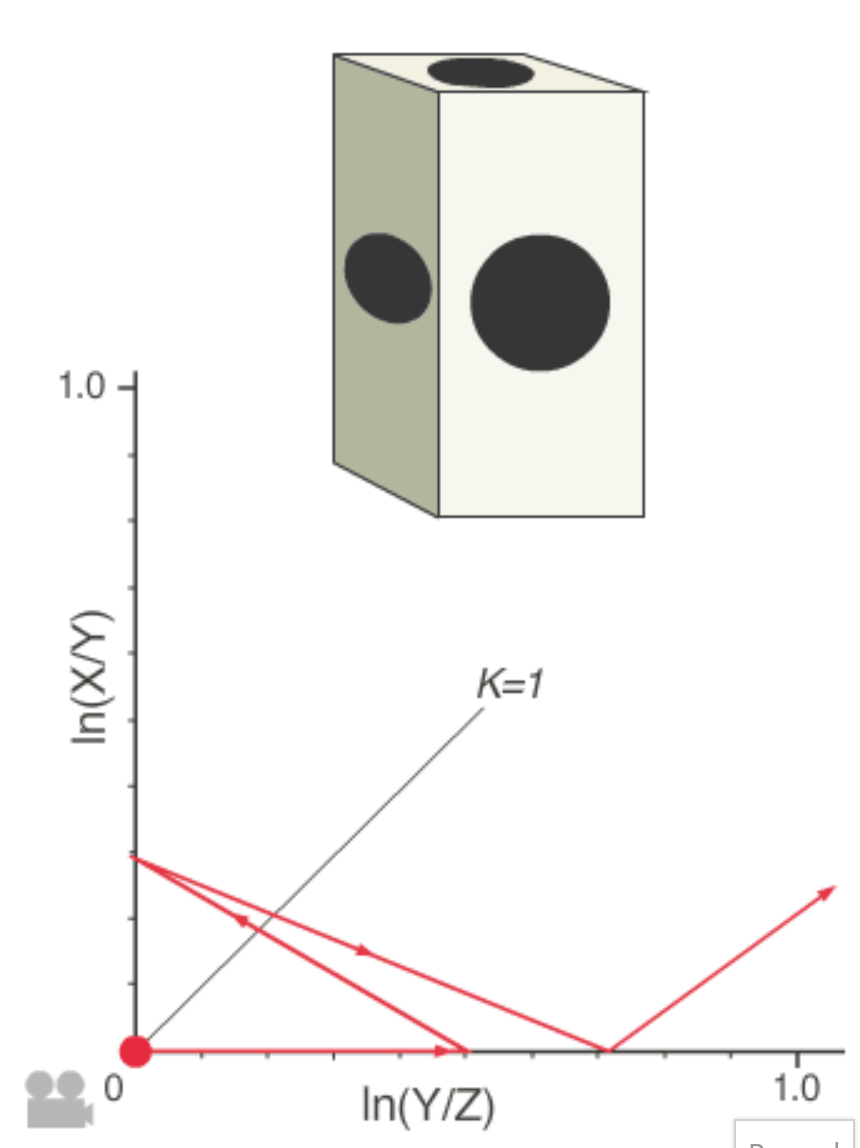 <!-- .element style="float: right" width="80%" --> </div> </div> <--o--> <!-- .slide: data-background="Module-v-Ductile-Deformation/Figures-Structures-Associated-with-Folding-1/Photos/Fossen_Chap12_SlatyCleavage.jpg" --> <--o--> <!-- .slide: data-background="Module-v-Ductile-Deformation/Figures-Structures-Associated-with-Folding-1/Photos/slate.jpg" --> <--o--> <!-- .slide: data-background="Module-v-Ductile-Deformation/Figures-Structures-Associated-with-Folding-1/Photos/slate2.jpg" --> <--o--> <!-- .slide: data-background="Module-v-Ductile-Deformation/Figures-Structures-Associated-with-Folding-1/Photos/Slaty_cleavage_wikipedia.jpg" --> <--v--> Metamorphosed shale depicting slaty cleavage. Note the grains of mica, quartz, and ilmenite aligned with a preferred orientation. [Source: Wikipedia](https://en.wikipedia.org/wiki/Cleavage_(geology)#/media/File:Slaty_cleavage.jpg) <--o--> ### Development of Secondary foliations #### Early tectonic development Early tectonic **Domainal cleavage** are often **Disjunction cleavage** which means they cut across than rather crenulates (folds) preexisting cleavage.  <!-- .element width="50%" --> [source: Haakon Fossen]() <--o--> ### Development of Secondary foliations #### Greenshist facies, from cleavage to shistosity <div> <div style="width:50%; float:left"> New philosilicates grow at the expense of clay minerals in shales and slates (**philitic cleavage**) New micas grow larger (visible in hand sample) with new basal planes more or less perpendicular to the Z-axis of the strain ellipsoid and more or less perpendicular to $\sigma 1$. We have a more pronunced development of the **QF** and **M** domains as the wet dissolution or **pressure solution** becomes more efficient. Foliation is no longer a cleavage but a shistosity. The rock is a **shist**. </div> <div style="width:50%; float:right">  <!-- .element style="float: right" width="90%" --> </div> </div> <--v-->  <!-- .element style="float: center" width="50%" --> **Left:**: Phyllitic cleavage in lower greenshist facies phyllite. **Right:** This cleavage formed higher into the greenshist facies, showing very well-developed QF- (middle) and M-domains and coarser grain size. <--o--> <!-- .slide: data-background="Module-v-Ductile-Deformation/Figures-Structures-Associated-with-Folding-1/Photos/1280px-NY-Central-Park-Rock-7333_shist_wikipedia.jpg" --> <--o--> ### Development of Secondary foliations: greenshist facies, from cleavage to shistosity While wet diffusion (pressure solution) governs cleavage formation, crystal plastic deformation mecanisms become more important during the formation of shistosity. <--o--> #### Secondary tectonic cleavage A preexisting foliation can be affected by a later cleavage ($S_2$ or higher), as a result of reorientation of the stress field for example. <div> <div style="width:50%; float:left"> The existing foliation is overprinted, generally via folding. We obtain a **crenulation cleavage** A series of microfolds, <1cm with parallel axial surfaces. </div> <div style="width:50%; float:right">  <!-- .element style="float: right" width="90%" --> </div> </div> Depending on the angle between the existing foliation and the stress orientation, the crenulation will be symmetric or asymmetric. <--o--> #### Secondary tectonic cleavage A preexisting foliation can be affected by a later cleavage ($S_2$ or higher), as a result of reorientation of the stress field for example. <div> <div style="width:50%; float:left"> The existing foliation is overprinted, generally via folding. We obtain a **crenulation cleavage** A series of microfolds, <1cm with parallel axial surfaces. </div> <div style="width:50%; float:right"> 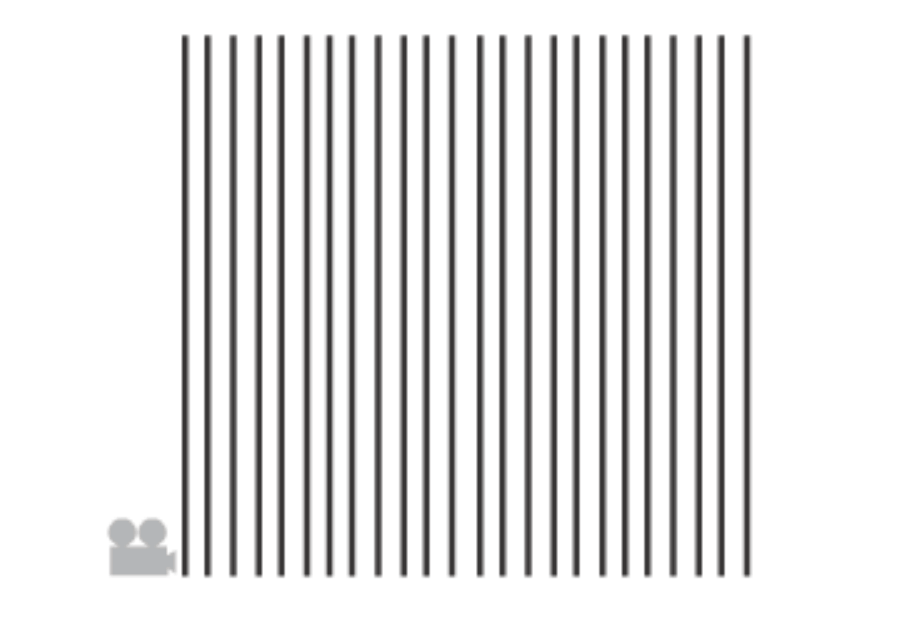 <!-- .element style="float: right" width="90%" --> </div> </div> Depending on the angle between the existing foliation and the stress orientation, the crenulation will be symmetric or asymmetric. <--o--> <!-- .slide: data-background="Module-v-Ductile-Deformation/Figures-Structures-Associated-with-Folding-1/Photos/crenulationcleavageslate.jpg" --> <--o--> <!-- .slide: data-background="Module-v-Ductile-Deformation/Figures-Structures-Associated-with-Folding-1/Photos/crenulation_wikipedia.jpg" --> <--o--> ## Bedding / Cleavage relationships <div> <div style="width:50%; float:left"> Cleavage is commonly associated with folding and typically runs parallel to the axial surface. We can use the term **axial plane cleavage** </div> <div style="width:50%; float:right">  <!-- .element style="float: right" width="90%" --> </div> </div> <--o--> ## Bedding / Cleavage relationships <div> <div style="width:50%; float:left"> Cleavage is commonly associated with folding and typically runs parallel to the axial surface. Cleavage develops more or less along the axial plane of folds. **axial planar** cleavage are an important link between tectonic foliation and folds in deformed rocks. </div> <div style="width:50%; float:right"> 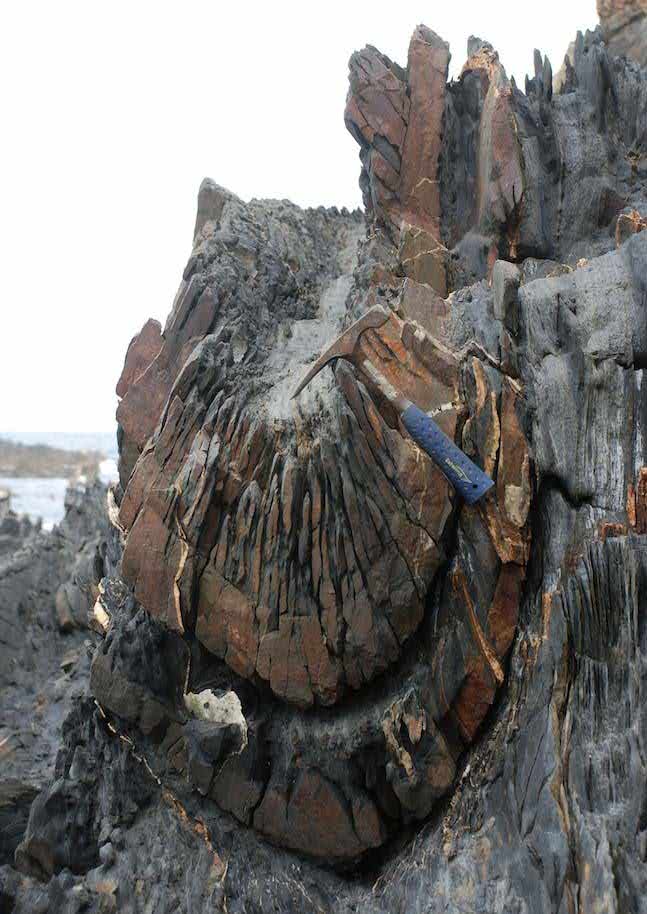 <!-- .element style="float: right" width="80%" --> </div> </div> <--o--> ## Bedding / Cleavage relationships  <!-- .element width="90%" --> <--o--> ### Pumpelly's Rule  <!-- .element width="90%" -->> <--o--> <!-- .slide: data-background="Module-v-Ductile-Deformation/Figures-Structures-Associated-with-Folding-1/Photos/Virginia DGMR on Twitter.jpeg" --> <--o--> ### Axial planar cleavage Cleavage shows a fairly consistent orientation across folds. This is extremely useful when mapping a region. <--o--> ### Schistosity <div> <div style="width:50%; float:left"> When recystallization is rapid and widespread the minerals get coarse, as does the foliation. In micashists the foliation gets less planar and more wavy as it is disturbed by mineral such as garnet, amphibole etc. </div> <div style="width:50%; float:right"> 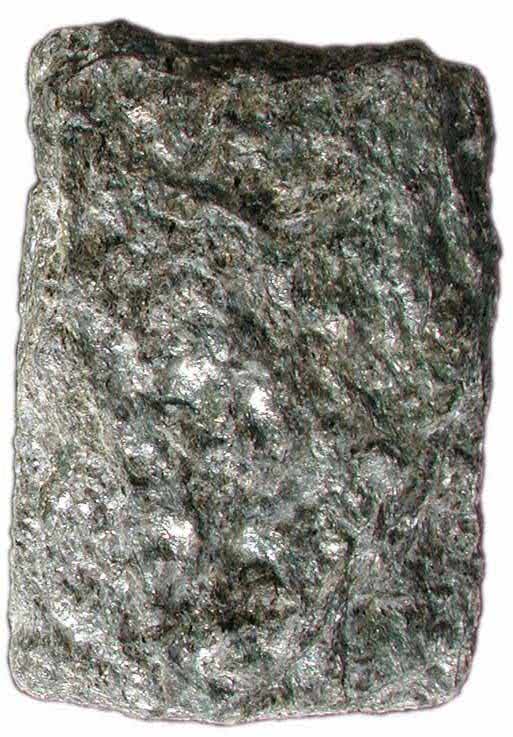 <!-- .element style="float: right" width="80%" --> </div> </div> <--o--> ### Schistosity <div> <div style="width:50%; float:left"> Quartz shist show shiny micas easily visible. The aligned micas define the schistosity together with the shape of elongated quartz grains. </div> <div style="width:50%; float:right"> 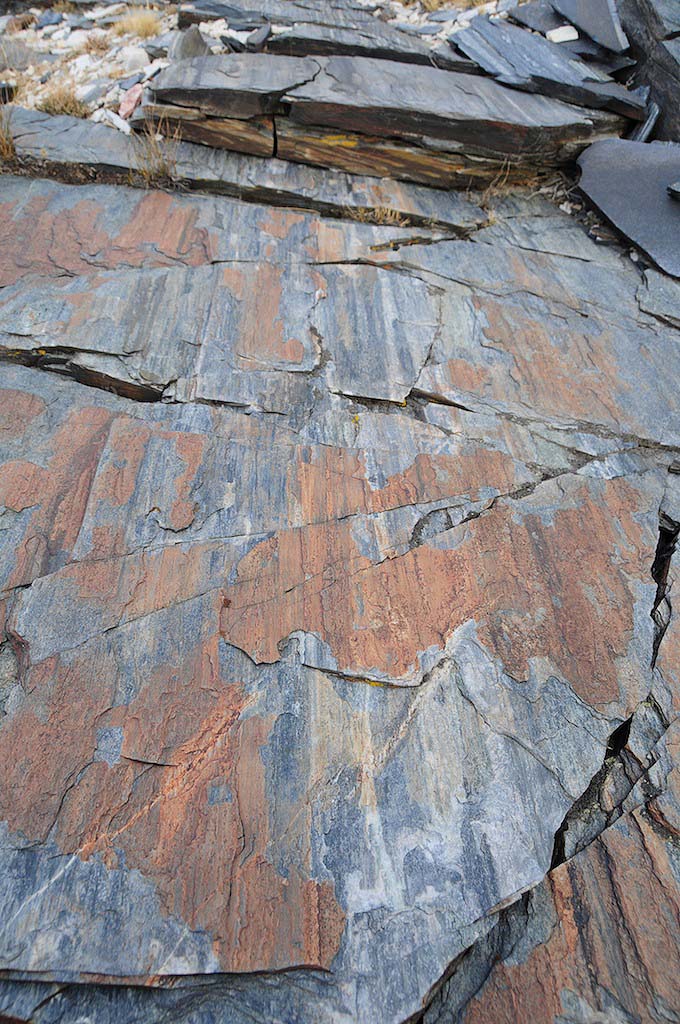 <!-- .element style="float: right" width="80%" --> </div> </div> <--o--> ### Gneissic Foliation <div> <div style="width:50%; float:left"> The banding or layering seen in gneiss define a **gneissic foliation**. It consists of layers of contrasting compositions, rotated and flattened structures such as veins, dykes etc. Gneiss commonly contains several foliations referred to as **composite foliations** Genissic foliations may be **migmatitic** when partial melting is involved, **mylonitic** when strain is very high. </div> <div style="width:50%; float:right">  <!-- .element style="float: right" width="80%" --> </div> </div> <--o--> ### Cleavage refraction **cleavage refraction** can be observed across layers of contrasting viscosities or competences. <--o--> ### Transected folds Sometimes, there is difference between the orientations of cleavages and the axial plane, even when cleavage and folds are genetically related and in absence of cleavage refraction. **transecting cleavage** describe a cleavage that intersects the axial surface and the fold hinge. The folds are referred to as **transected folds**. Interpretated as the result of transpressive regime, where folds and cleavage rotates and where there is a slight time difference between the formation of folds and cleavages. They can also form during co-axial deformation when the ISA rotates. <--o--> ## Relationships between cleavage and strain Most cleavage approximate the XY plane of the stress ellipsoid. Pressure solution is largely responsible for the oblates strain ellipsoids and the large volume loss associated with cleavage formation. Compaction in sediment, which generally occurs at low-temperature and shallow depth can involves a 30-40% reduction in volume. Pressure solution in limestone can accommodate up to 70% shortening. <--o--> ## Relationships between cleavage and strain Cleavage and foliations are not always the result of coaxial shortening. Non-coaxial shearing can result in the development of shear zones that look similar to axial planar cleavage.